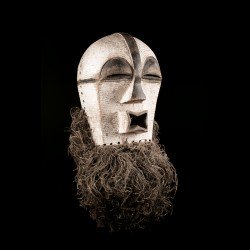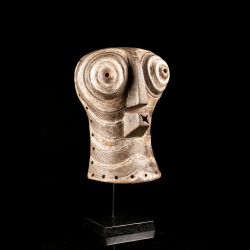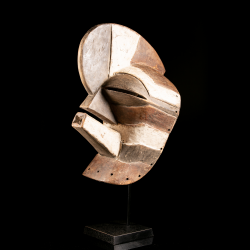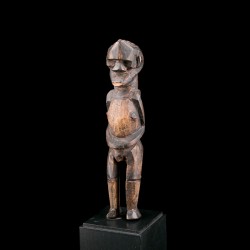


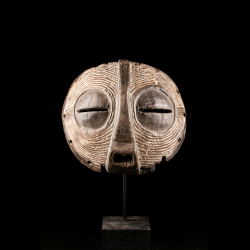









In African art from D.R. Congo, traditional Luba masks like these are relatively rare.
They are sometimes confused with the striated masks, better known from the Songye and Kalebwe and related populations.
It is likely, in fact, that the striated masks of certain northern Luba groups present formal analogies with the masks of their more common Songye neighbours.
The black and white stripes may refer to the same symbolism as that of the Kifwebe masks (pl. Bifwebe) of the Songye and evoke bushbuck, zebras and other animals that the Luba consider ambiguous.
"Bifwebe" is a generic term, used by the Luba, Tabwa and other neighboring populations to designate 'masks' (although this term can also define the wearer or the society that uses the masks, as is the case among the Songye).
Traveling masked figures are reported to have occasionally visited villages and performed dances with bifwebe, as an entertainment show, in exchange for food and goods. These masks being linked to witchcraft, of yesteryear, parents warned rambunctious children that if they did not change their behavior, the bifwebe masks would come and take them away.
Data sheet
You might also like

In African art from D.R. Congo, traditional Luba masks like these are relatively rare.
They are sometimes confused with the striated masks, better known from the Songye and Kalebwe and related populations.
It is likely, in fact, that the striated masks of certain northern Luba groups present formal analogies with the masks of their more common Songye neighbours.
The black and white stripes may refer to the same symbolism as that of the Kifwebe masks (pl. Bifwebe) of the Songye and evoke bushbuck, zebras and other animals that the Luba consider ambiguous.
"Bifwebe" is a generic term, used by the Luba, Tabwa and other neighboring populations to designate 'masks' (although this term can also define the wearer or the society that uses the masks, as is the case among the Songye).
Traveling masked figures are reported to have occasionally visited villages and performed dances with bifwebe, as an entertainment show, in exchange for food and goods. These masks being linked to witchcraft, of yesteryear, parents warned rambunctious children that if they did not change their behavior, the bifwebe masks would come and take them away.

